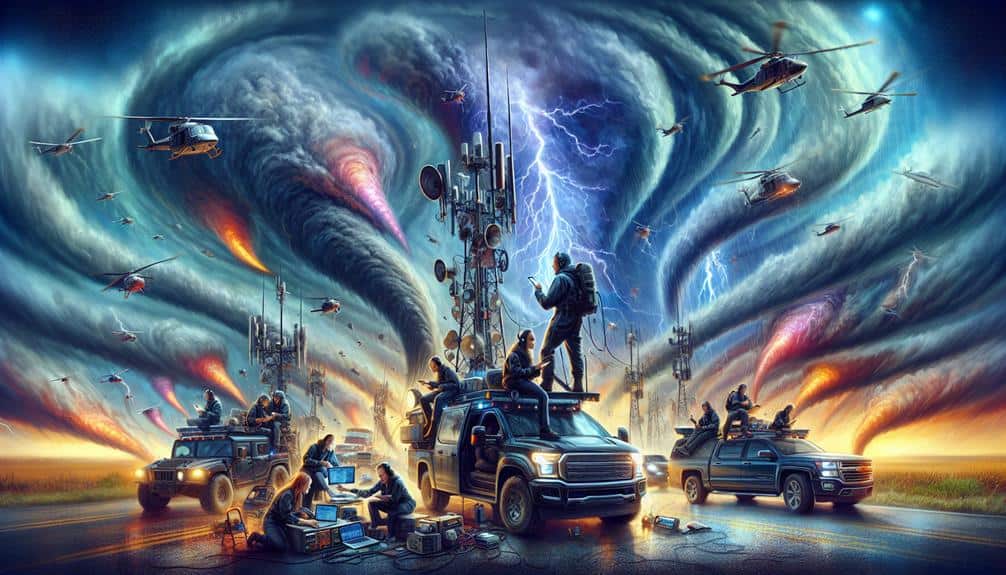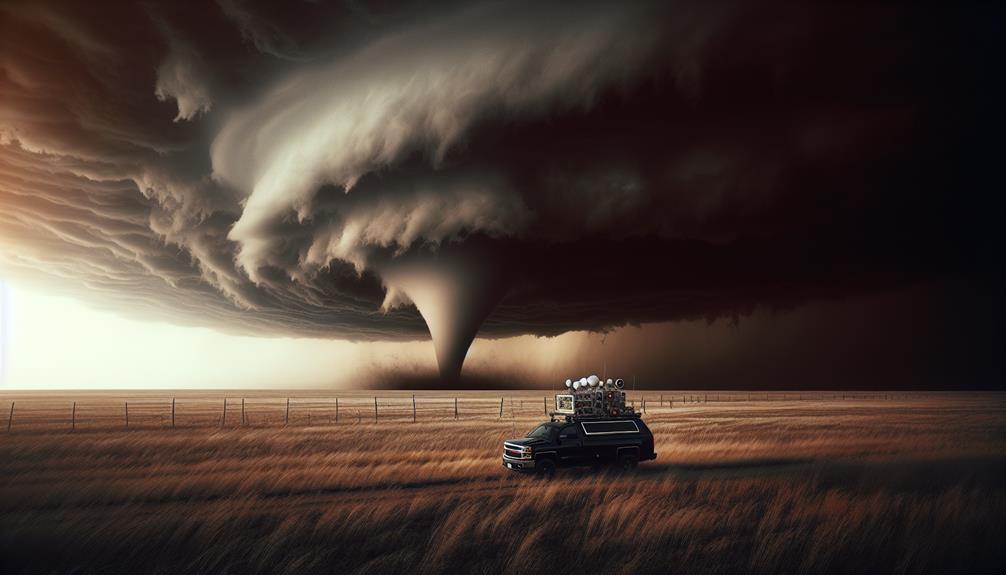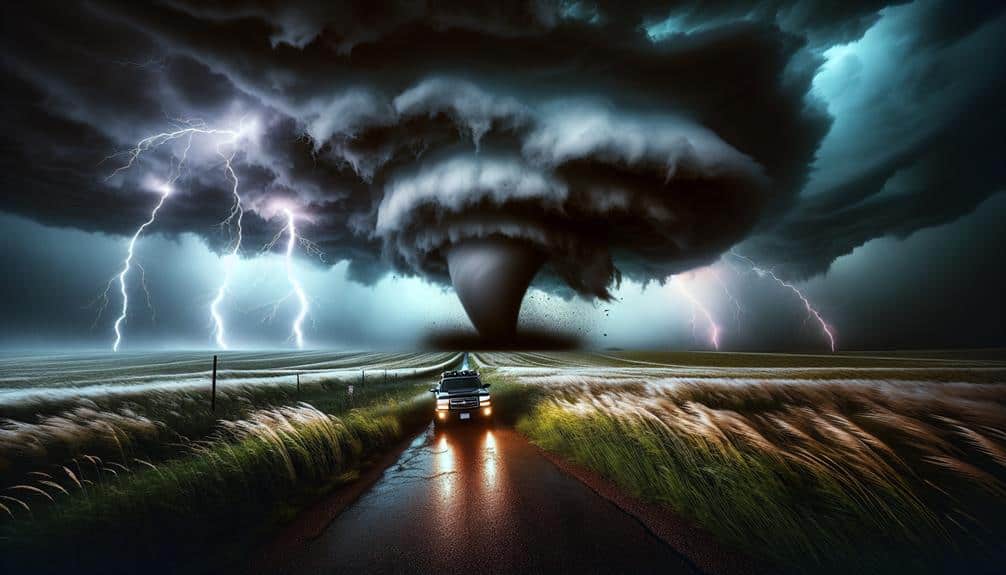Storm chasing captivates our passion as we utilize meteorological knowledge and cutting-edge equipment to explore severe weather phenomena. By analyzing temperature, humidity, wind speed, and pressure variations, we anticipate storm behaviors. Our toolkit includes drones for real-time data, Doppler radar for movement tracking, and robust communication devices for safety. Rigorous risk assessment, fortified vehicles, and real-time updates keep us protected. Detailed data collection through remote sensing and aerial surveys enhances our predictive models. Our fieldwork combines these elements with compelling case studies, emphasizing the exhilarating yet meticulous nature of storm chasing. Join us to reveal the full depth of our pursuit.
Key Points
- Meteorological fundamentals are crucial for predicting storm behavior and understanding weather patterns.
- Cutting-edge technology, including drones and Doppler radar, enhances real-time storm tracking and data collection.
- Risk assessment ensures storm chasers' safety through vehicle reinforcements, emergency supplies, and real-time updates.
- Data collection combines remote sensing and aerial surveys for comprehensive atmospheric analysis.
Meteorological Fundamentals
Understanding the meteorological fundamentals is essential for storm chasers because it enables us to predict storm behavior with greater precision. By analyzing weather patterns and atmospheric conditions, we can identify potential storm formations and their trajectories. Key meteorological elements include temperature, humidity, wind speed, and pressure variations. These factors interact in complex ways, forming the basis of storm genesis and evolution.
We must pay close attention to weather patterns, such as cold fronts, warm fronts, and dry lines, which often serve as catalysts for severe weather events. For instance, when a cold front advances, it forces warm, moist air to rise rapidly, leading to the development of thunderstorms. Simultaneously, atmospheric conditions like wind shear—a variation in wind speed and direction with altitude—can significantly influence storm intensity and formation.
Utilizing data-driven approaches, we analyze historical weather data and real-time observations to forecast storm paths. This analytical rigor allows us to position ourselves strategically, maximizing both safety and the opportunity to witness these awe-inspiring natural phenomena. By mastering meteorological fundamentals, we not only enhance our predictive capabilities but also embrace the freedom to chase storms with assurance and precision.
Technology and Equipment
Cutting-edge technology and specialized equipment are essential tools for storm chasers, enabling us to monitor, track, and analyze severe weather events with unparalleled accuracy. Drone technology has revolutionized our ability to gather important data from otherwise inaccessible areas. Equipped with high-resolution cameras and sensors, drones provide real-time imagery and atmospheric readings, enhancing our predictive models.
Radar systems are the backbone of storm tracking, offering detailed insights into storm cell formations and movements. Doppler radar is particularly invaluable, allowing us to detect wind patterns, precipitation levels, and potential tornado formations. This data is vital for making informed decisions about where to position ourselves for optimal observation while maintaining safety.
Our camera gear, including high-speed and 360-degree cameras, captures every nuance of a storm's development. These images not only contribute to scientific research but also bring the raw power of nature to the public eye, fostering a deeper appreciation and understanding of severe weather phenomena.
Communication devices, such as satellite phones and dedicated radio systems, ensure we stay connected with our teams and emergency services. Reliable communication is important for coordinating efforts and sharing real-time data, making our storm chasing endeavors both effective and safe.
Risk Assessment
Evaluating risks is a critical component of our storm chasing strategy, ensuring we navigate severe weather scenarios with both precision and safety. We start by analyzing meteorological data to predict storm paths and intensities. This allows us to position ourselves at best vantage points while maintaining a safe distance. Safety measures are meticulously planned; our vehicles are equipped with reinforced structures and emergency supplies, and we always have multiple escape routes mapped out.
The adrenaline rush inherent in storm chasing can cloud judgment, but we counteract this by adhering to strict protocols. For instance, we monitor real-time weather updates and maintain constant communication with local authorities and fellow chasers. Additionally, we use advanced radar systems and GPS to track storm movements, thereby minimizing exposure to potentially lethal conditions.
Our analytical approach includes risk matrices that evaluate the probability and impact of various hazards, such as hail, lightning, and tornadoes. These matrices are updated continuously based on incoming data, ensuring our decisions are informed and adaptive.
Data Collection Methods
Leveraging our thorough risk assessments, we employ a range of sophisticated data collection methods to capture high-resolution meteorological information during storm chases. Our primary tools include remote sensing technologies and aerial surveys, both of which offer unparalleled precision and scope.
In remote sensing, we utilize radar and satellite imagery to track storm systems in real-time. This technology allows us to measure parameters like wind speed, precipitation rates, and atmospheric pressure from a safe distance. By integrating data from multiple sensors, we can form a detailed view of the storm's structure and dynamics.
Aerial surveys add another layer of depth to our data collection. Using drones and manned aircraft, we gather critical information from altitudes that ground-based instruments can't reach. These aerial platforms are equipped with advanced sensors that capture high-resolution visual and thermal images, enabling us to study storm development and behavior in intricate detail.
Combining these methods, we generate a robust dataset that not only enhances our understanding of severe weather phenomena but also improves predictive models. This meticulous approach empowers us to chase storms safely and effectively, pushing the boundaries of meteorological science while embracing the freedom of the open sky.
Case Studies and Findings

Our extensive fieldwork has produced several compelling case studies that highlight the effectiveness of our data collection methods in understanding storm patterns and behavior. One notable case involved a supercell in Oklahoma, where we tracked the storm's evolution using GPS and Doppler radar. The precise data points allowed us to predict the tornado touchdown within a 10-mile radius, demonstrating the accuracy of our techniques.
In another instance, we studied the psychological impact and adrenaline rush experienced by storm chasers. Surveys and biometric data indicated heightened cortisol levels during peak storm activity, supporting the intense emotional and physiological responses involved.
Ethical considerations and public safety remain paramount in our research. In a Texas case study, we collaborated with local authorities to guarantee our presence didn't endanger residents. Our findings stressed the importance of real-time communication and adherence to safety protocols, promoting a responsible storm-chasing culture.
Frequently Asked Questions
What Motivates Storm Chasers to Pursue Such a Dangerous Hobby?
We're driven by psychological motivation and the adrenaline rush. We conduct risk assessment and follow strict safety precautions. The thrill of freedom and understanding nature's power make storm chasing an irresistible and calculated endeavor.
How Do Storm Chasers Deal With the Stress of Extreme Weather Conditions?
We thrive on adrenaline and sheer madness! But seriously, we use coping mechanisms like mental preparation and data analysis. We trust our training and equipment, embracing the freedom to chase with a disciplined, analytical approach.
What Personal Qualities Make Someone a Successful Storm Chaser?
The personal qualities that make us successful storm chasers include perseverance, dedication, courage, and resilience. We analyze data meticulously, stay committed despite challenges, and face extreme conditions head-on, ensuring we can pursue our passion for freedom.
How Has the Media Portrayal of Storm Chasers Affected Public Perception?
Media's influence on public perception of storm chasers, driven by sensationalism, has ethical implications. "Don't judge a book by its cover" is apt here. Sensational media portrayals often overshadow the data-driven, analytical work of responsible chasers.
We've heard storm chasers recount thrilling adventures and unforgettable moments, often highlighting close encounters with tornadoes and the breathtaking beauty of supercells. These experiences, backed by data, showcase the raw power and freedom of nature's extremes.


